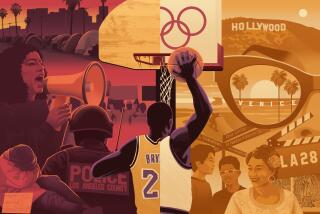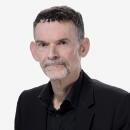Navel-Gazing in the City That Made It an Art Form
- Share via
The title had an imposing ring: “Los Angeles at the Millennium--Identity and Community in the 21st Century City.” The speakers’ lineup was stacked with literary and cultural heavyweights: Mike Davis, James Ellroy, Carolyn See. Even the official poster design conveyed a sense of momentous occasion: pointillist rows of L.A. city lights, blazing away toward an endless horizon under a purple-and-gold Wagnerian sky.
A tough billing, perhaps, for any conference to live up to. And, as it turned out, this inaugural public symposium sponsored by the Los Angeles Institute for the Humanities at USC only once or twice reached the level of high drama or revelation.
But for the speakers, panelists and several hundred other people who showed up at USC on Friday night and Saturday, the free symposium offered a chance to revisit some quintessential L.A. themes, exchange gossip with friends and colleagues, enjoy some lively impromptu street theater and take the pulse of a city that, in the words of California State Librarian and conference moderator Kevin Starr, “if it ever stopped trying to define itself would disappear from the face of the Earth.”
Of course, as Starr suggested, this was hardly the first symposium dedicated to a metropolis whose civic motto could almost be, “We introspect, therefore we are.” What made this one feel slightly different was the crowd. Yes, there were the usual scholars, journalists and public policy wonks who turn up at these affairs.
But there also were spoken-word poets from Koreatown, trade union leaders, aspiring novelists, community activists, MTA urban planners, artists, lawyers, screenplay authors and various and sundry bohemians. Though the panel groups contained many of the usual suspects, the thinking was predominantly left-of-center and the paradigms weren’t exactly freshly minted, the atmosphere was refreshingly nonacademic and informal. “It’s nice to see there’s people with purple hair,” observed Francis DellaVecchia, a one-time unsuccessful L.A. mayoral candidate.
Much of the conference discussion contrasted private and public visions of Los Angeles, the desire to engage L.A. at a meaningful personal level versus the need to collectively address its enormous social and economic challenges. There were calls not only for aiding the city’s poor but for nurturing its imagination, for finding a shared “narrative” to express the city’s unique history and prismatic sense of self.
Conceived as a bridge between town-and-gown interests, the 4-year-old institute had held previous speaker engagements, but none on the scale of last weekend’s. “This time we wanted to take a series of issues that were far bigger than we could handle,” said Steve Ross, a USC history professor and the institute’s co-director with Steve Wasserman, editor of The Times’ Book Review section.
But before getting down to the business of panel discussions, the conference absorbed an eloquent tongue-lashing from keynote speaker Davis, the neo-Marxist scholar, author (“City of Quartz,” “Ecology of Fear”) and MacArthur Fellowship (“genius grant”) winner. A longtime scourge of the city’s boosters and shakers (City Hall, the Chamber of Commerce, The Times), Davis, sporting a white beard and a tan, unleashed a vintage, scathing critique of L.A.’s social inequities.
Now back in Southern California after a few years on Long Island, Davis drew parallels between slummy, corrupt New York City, 1902, and the teeming immigrant mecca of Los Angeles, 2002. L.A., he said, is a place where the low-wage immigrant labor and “Dickensian poverty” of the many subsidize the “luxury lifestyles” of the few. Where childhood poverty and youth unemployment rates are at Depression-era levels, while crime statistics show L.A. to be “a far more dangerous place than the New York City of ‘Godfather II.’” (America’s biggest city was a frequent reference point throughout the conference, in what Starr later termed “the New York metaphor, almost the New York envy.”)
Leaving no fat cat unflayed, Davis upbraided Playa Vista developers, “the secessionists of Sherman Oaks,” and the recent spate of lavish cultural temples that look down on a decaying metropolis. He even chided the institute, which “in its bold attempt to create an Algonquin Round Table,” he said, had missed an opportunity by not inviting Chicano studies professor Rudy Acuna, sci-fi/fantasy writer Octavia Butler or some other non-Anglo personage of letters to deliver the keynote address instead of him. He closed by exhorting Angelenos to start a social “revolution” so as to save their city from being “downsized by greed.”
Well. While Davis joked that the purpose of his speech was “to ensure that I’d never be invited back,” the Chardonnay-sipping, cheese-munching crowd ate it up. Most stood and applauded. One man yelled “Yeah!” from the back of the room.
At Q&A; time, however, Davis’ thunder was co-opted by Mike Sonksen, a.k.a. MIKEthePOET, who stood and delivered a righteous, minutes-long hip-hop recitative (“I’m ALIVE in Los Angeles!”) on the city’s charms and blemishes. Two accomplices backed him up with body-slapping “percussion” while Davis stood smiling, arms folded. “You want to respond in rap, Mike?” Starr finally asked Davis.
Next morning at 10, when the conference resumed, many of Davis’ themes hung in the air like the rain clouds that scampered over the campus. In the first of two panel discussions, KPCC radio host Larry Mantle guided an eclectic four-member group on the theme of “Boomtown Blade Runner: Los Angeles and Its Multiple Futures.” Segueing from nuts-and-bolts questions of jobs, political representation and mutating Census data, the panel also pondered how the city’s quest for harmony and “social justice” could be translated into a common story line.
Lakewood city official and author D.J. Waldie (“Holy Land: A Suburban Memoir”) voiced concern that Angelenos lack “a coherent narrative of our lives together.” The old L.A. narrative, Waldie said, was essentially a “sales pitch” concocted by real estate speculators and marketing men intent on parceling up and selling off an Arcadian fantasyland to East Coast and Midwest immigrants. He suggested that L.A. now must find a new “narrative” to replace the carny barker’s call.
A new narrative was fine with community activist Madeline Janis-Aparicio, executive director of the Los Angeles Alliance for a New Economy. But she believes that narrative already is being written by working-class immigrants, who are organizing themselves around grass-roots community and labor issues. Political empowerment, she suggested, is the key to building a strong group identity, a shared progressive story line. Los Angeles, she said, is “in denial. It refuses to accept that poverty is our No. 1 challenge.”
USC history professor George Sanchez picked up on the theme, emphasizing that L.A.’s emergence as “an increasingly Latino city,” in line with California’s similar direction, had supplied a new narrative that encompassed Fresno farm workers as much as the nannies, gardeners and pool cleaners who shuttle from Boyle Heights to Brentwood. “There’s a narrative we’re missing,” he said. “It’s about family, it’s about dreams for the future, it’s about transforming our community.”
Harold Meyerson, former L.A. Weekly editor and now executive editor of the American Prospect magazine, agreed that the city suffered from the “absence of a broad civic consciousness.” This, he said, was caused by such factors as racist white flight, corporate disinvestment, the sprawling size of county supervisor districts, the mutual “invisibility” of different ethnic and economic groups and, possibly above all, the collapse in the early ‘90s of the aerospace-dependent middle class. “What happened was, the bottom didn’t drop out of the L.A. economy, the middle did,” Meyerson said. These anxieties have stoked the city’s overlapping secession movements and what Meyerson called a “privatization of identity.”
“Do you have any prescriptives out of this?” asked Mantle, who’d been deftly goosing the conversation by playing devil’s advocate. On a more positive note, Meyerson cited Antonio Villaraigosa, who lost last year’s mayoral election to James Hahn, as an example of a potential liberal coalition builder in the old Bradley mold.
Lunch in the library courtyard was pure L.A. homestyle: spicy chicken and beef, frijoles, arroz and tortillas. If the morning panel was about defining L.A. as a community, the afternoon session was about how that community gets filtered through an artistic sensibility--the L.A. of memory and desire rather than the L.A. of hard facts.
Meeting in the Intellectual Commons on the second floor of Doheny Memorial Library, the four-person panel--novelists Ellroy (“L.A. Confidential”) Walter Mosley (“Devil in a Blue Dress”) and Bruce Wagner (“I’m Losing You”) and novelist-memoirist See (“Dreaming”)--pondered L.A. as a city of the mind. Moderator Michael Silverblatt, of KCRW’s “Bookworm” program, said he hoped that “this panel will be more raffish and up-startish than the other.”
It wasn’t long before the tough-guy talk was flying, principally from Ellroy and Wagner. Both disavowed any direct connection to L.A.’s high-culture literary roots (Nathaniel West, Budd Schulberg), professing instead a love of Mickey Spillane and the pulpier prose pros. “I didn’t read ‘What Makes Sammy Run?’ until three years ago. I didn’t read any of that [expletive],” Wagner said.
Ellroy credited his becoming a writer to his father giving him a copy of “The Badge” on his 11th birthday, and to the simple accident of birth. “I was lucky my parents hatched me in a great locale with a sexy criminal tradition,” he said. Now living in Kansas City, Ellroy said that when he visits his old neighborhood at Beverly and Western in Koreatown, “I can’t even read the signs.” The native son is now a stranger in a strange land. But L.A. still grips him, he said, like a “hungry pit bull” with its jaws affixed to a vulnerable part of his anatomy. “L.A. is a life sentence,” he concluded.
See said she, too, still gets lost in certain parts of town. The city’s variety and expanse makes it “a place you can’t get a handle on,” she said, but what’s wrong with that for a novelist? “You couldn’t possibly get it all in one novel, and why would you want to? You just have to pick the scrap that you have.” Mosley said that as a young writer, he’d found that many parts of L.A. “are just, like, unrecorded,” such as the experience of African Americans who came here after World War II from Texas and Louisiana. “I hope I’m able to take different voices at different times,” he said.
As the panel broke up, the audience started to drift toward the hallway and a waiting reception party. Flipping through a fistful of scribbled notes, Starr tried to make sense of the past 36 hours in a 15-minute wrap-up. “We are, over time, becoming more like each other,” he summarized. “That’s the glorious future, I think.”
More to Read
Sign up for our Book Club newsletter
Get the latest news, events and more from the Los Angeles Times Book Club, and help us get L.A. reading and talking.
You may occasionally receive promotional content from the Los Angeles Times.







